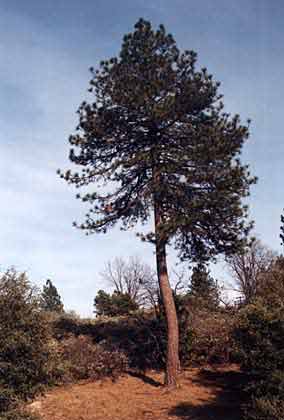
Ponderosa Pine at Alder Springs
"Anyone who keeps the ability to see beauty never grows old." -- Franz Kafka
Where do Pines fit into the Plant Kingdom ?

Ponderosa Pine at Alder Springs
"This structure
of concepts is formally called a heirarchy and since ancient
times has been a basic structure for all Western knowlege.
Kingdoms, empires, churches, armies have all been structured into
hierarchies... in some fields such as biology, the hierarchy
of kingdom-phylum-class-order-family-genus-species is almost an
icon."
-- Robert M. Pirsig, Zen and the Art of Motorcycle Maintenance
BOTANICAL CLASSIFICATION
KINGDOM: Plantae -- Relatively immobile organisms with indeterminate growth and presence of chlorophyll in cells which have walls containing cellulose.
SUBKINGDOM: Embryophyta -- The zygote (egg) and sperm have a layer of protective cells and the zygote is retained in the female sex organ where it divides into a mass of cells which differentiate into an embryo.
PHYLUM: Tracheophyta -- Plants contain vascular (conducting) tissues known as xylem and phloem in stems and roots and veins in leaves.
SUBPHYLUM: Pteropsida -- Plants with relatively large leaves and when they grow from the stem, they leave "leaf gaps" (an area with no vascular tissue) above their origin from the stem; leaf stems have a central pith (are siphonostelic).
CLASS: Gymnospermae -- Have no flower or fruit, but rather the ovule and (after fertilization) the seed are "naked" and wedged between the scales of a woody "cone" (or sometimes a fleshy berrylike cone or a peduncle or a scale with only 1 to 3 seeds).
SUBCLASS: Coniferophyta -- Trees with tapered trunks and whorles of smaller lateral branches, but sometimes diffusely branched and varying from small trees to prostrate shrubs; the stems have a small pith and thin cortex; the wood of the stems and trunk shows growth layers (annual rings).
ORDER: Coniferales -- Leaves are simple (one at each node) and arranged alternately, oppositely, in spirals, in whorls and have long narrow "needle" or scalelike configuration.
FAMILY: Pinaceae -- Have "female" flowers (megasporangiate strobili, i.e. "big spore cones", a.k.a. "cones") with a central axis (rachis) with pairs of scales set in helical or opposite arrangement and the paired cone scales consist of a sterile bract scale and above it a fertile scale which carries two ovules and (after fertilization) two seeds; and the smaller pollen-producing "male" flowers (microsporangiate strobili, i.e. "small spore cones", a.k.a. "catkins"); and the leaves are slender and needlelike, arranged singly or in clusters and persist more than one year ("evergreens") or are shed ("deciduous") after one growing season.
GENUS: Pinus -- Leaves are arranged in bundles of 2 to 5 (rarely 1, or up to 8 or more) and have a permanent or deciduous sheath at their bases and such bundles are called fascicles (after the bundle of sticks around the axe which represented the power of the Roman senate) and the individual "needles" (leaves) in one fascicle are segments of a circle and will form a cylinder if fitted together, hence the leaves have a triangular cross section; all species are evergreen.